The Photoelectric Effect | Physics for Grade 12 PDF Download
The photoelectric effect is the phenomena in which electrons are emitted from the surface of a metal upon the absorption of electromagnetic radiation
- Electrons removed from a metal in this manner are known as photoelectrons
- The photoelectric effect provides important evidence that light is quantised, or carried in discrete packets
- This is shown by the fact each electron can absorb only a single photon
- This means only the frequencies of light above a threshold frequency will emit a photoelectron
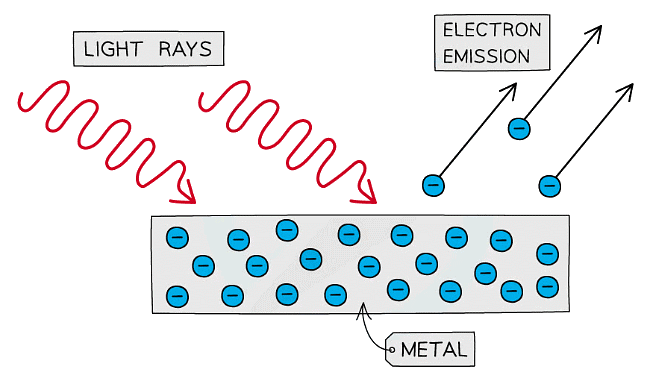 Photoelectrons are emitted from the surface of metal when light shines onto it
Photoelectrons are emitted from the surface of metal when light shines onto it
The Particle Nature of Light
- In classical wave theory, electromagnetic (EM) radiation is assumed to behave as a wave
- This is demonstrated by the fact EM radiation exhibits phenomena such as diffraction and interference
- However, experiments from the last century, such as the photoelectric effect and atomic line spectra, can only be explained if EM radiation is assumed to behave as particles
The Development of Quantum Physics
- The field of quantum mechanics is a relatively new field of research, compared to fields in classical mechanics (Newton’s laws, wave theory etc)
- Around 1900, discoveries, such as the electron and the gamma photon, began to conflict with the existing models scientists held about the nature of matter
- Soon after, new theories about the nature of matter began to emerge from Max Planck, Niels Bohr and Albert Einstein, who are seen as the pioneers of Quantum Theory
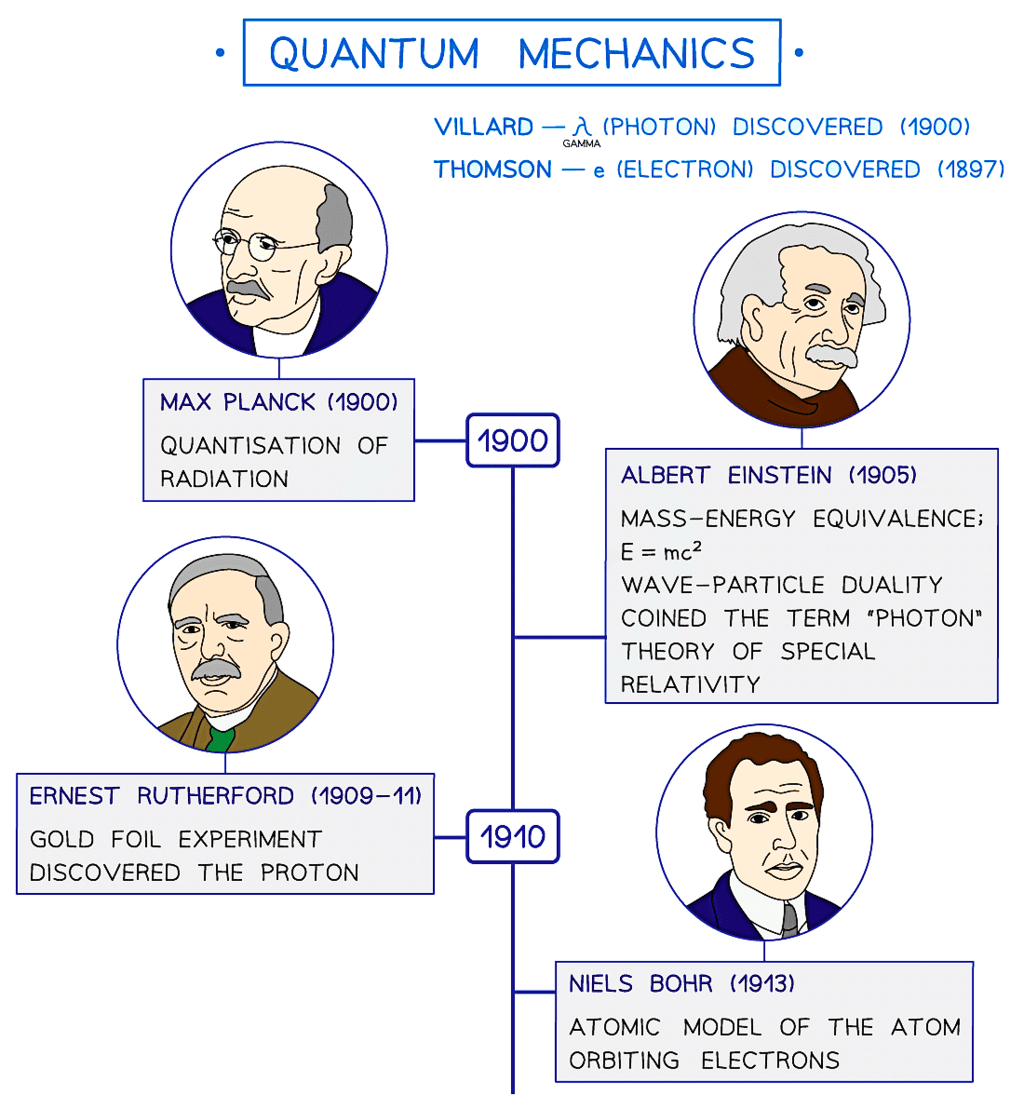
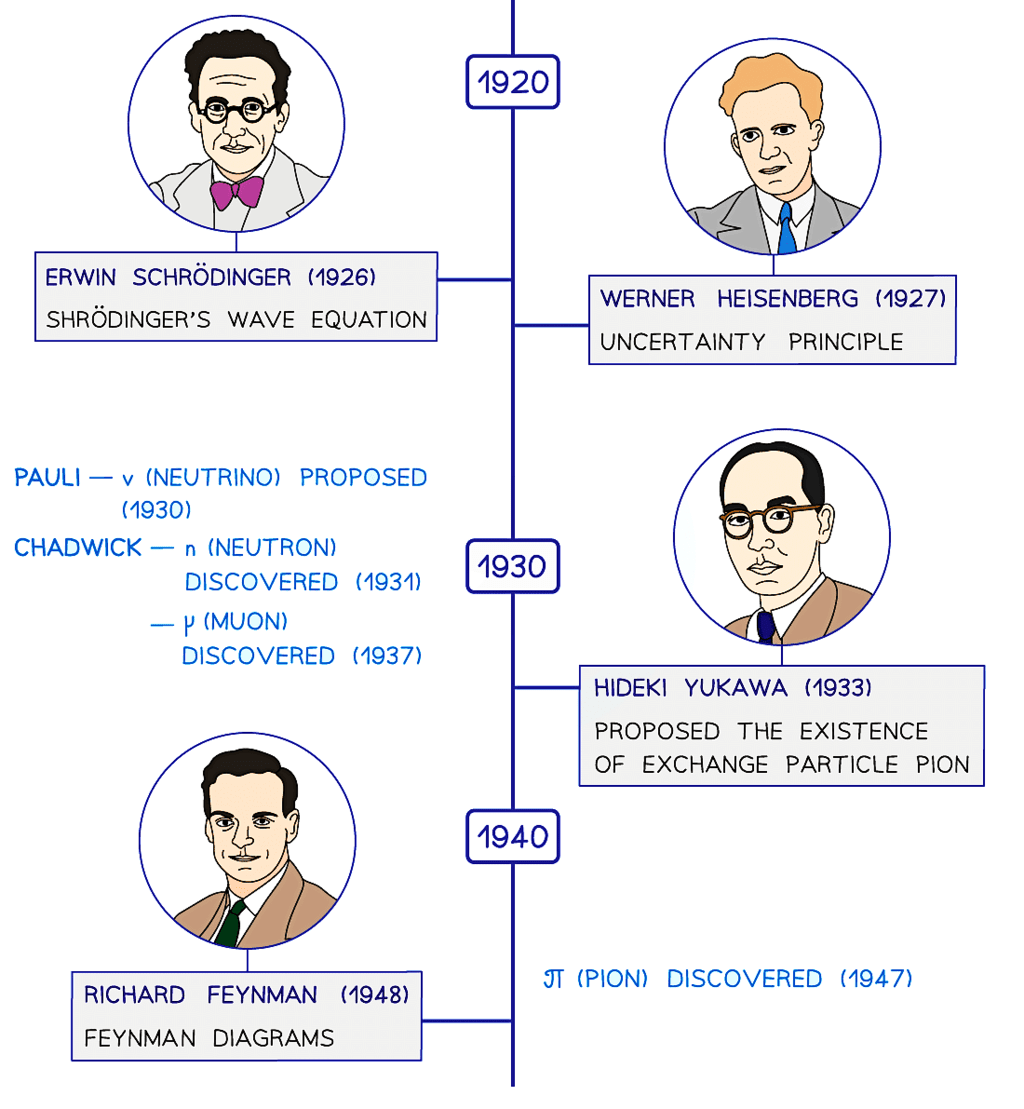
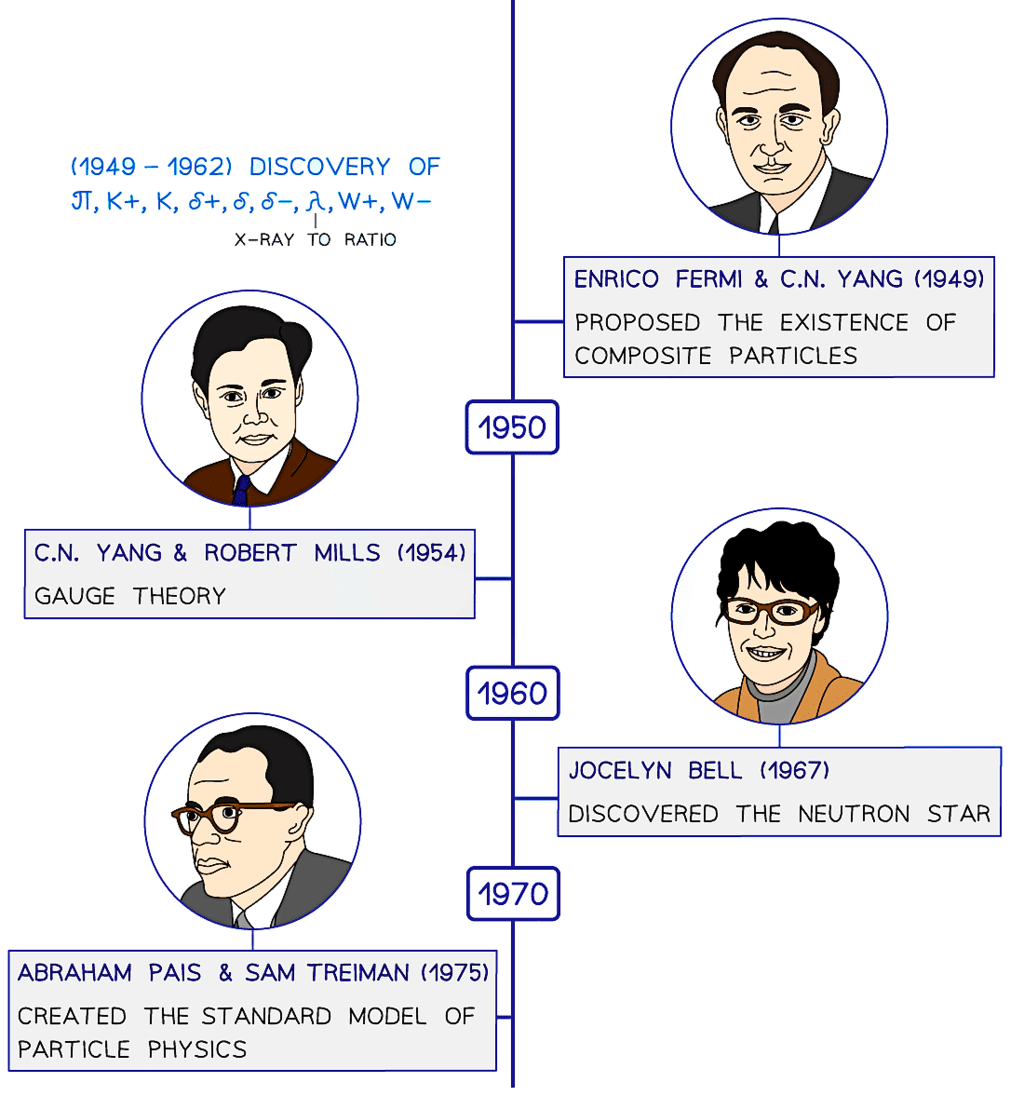
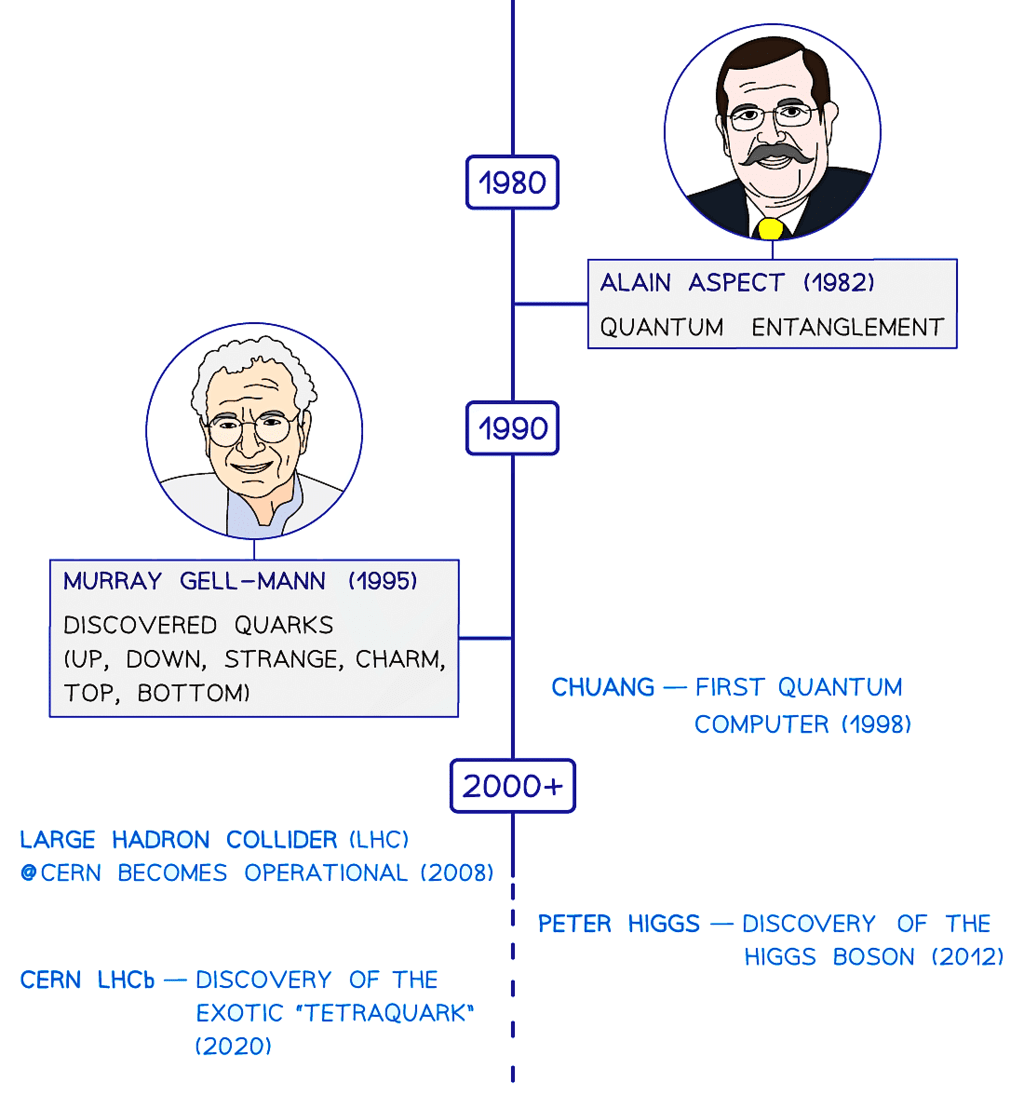 Timeline of the great advancements in quantum theory since 1900
Timeline of the great advancements in quantum theory since 1900
Demonstrating the Photoelectric Effect
- The photoelectric effect can be observed on a gold leaf electroscope
- A plate of metal, usually zinc, is attached to a gold leaf, which initially has a negative charge, causing it to be repelled by a central negatively charged rod
- This causes negative charge, or electrons, to build up on the zinc plate
- UV light is shone onto the metal plate, leading to the emission of photoelectrons
- This causes the extra electrons on the central rod and gold leaf to be removed, so, the gold leaf begins to fall back towards the central rod
- This is because they become less negatively charged, and hence repel less
Observations of the Gold Leaf Experiment
- Placing the UV light source closer to the metal plate causes the gold leaf to fall more quickly
- Using a higher frequency light source does not change how quickly the gold leaf falls
- Using a filament light source causes no change in the gold leaf’s position
- Using a positively charged plate causes no change in the gold leaf’s position
- Emission of photoelectrons happens as soon as the radiation is incident on the surface of the metal
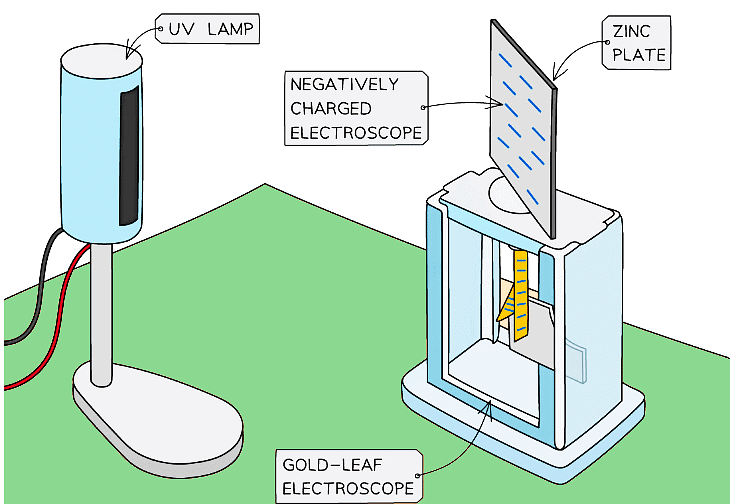
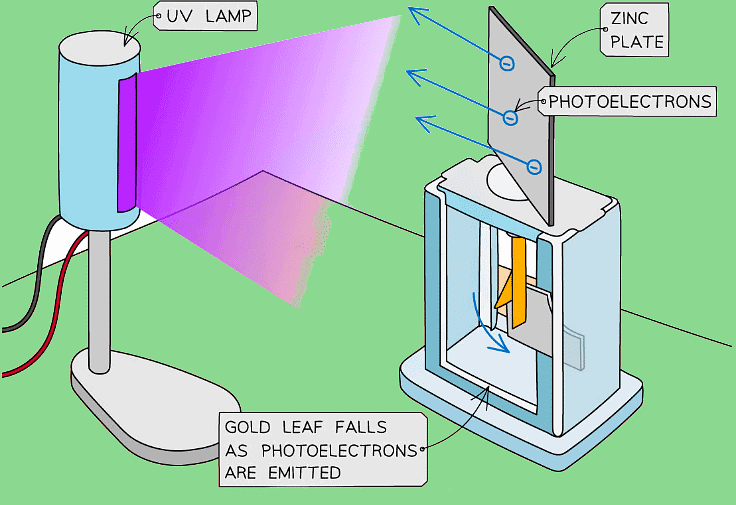 Typical set-up of the gold leaf electroscope experiment
Typical set-up of the gold leaf electroscope experiment
Explaining the Observations
Observation:
- Placing the UV light source closer to the metal plate causes the gold leaf to fall more quickly
Explanation:
- Placing the UV source closer to the plate increases the intensity incident on the surface of the metal
- Increasing the intensity, or brightness, of the incident radiation increases the number of photoelectrons emitted per second
- Therefore, the gold leaf loses negative charge more rapidly
Observation:
- Using a higher frequency light source does not change how quickly the gold leaf falls
Explanation:
- The maximum kinetic energy of the emitted electrons increases with the frequency of the incident radiation
- In the case of the photoelectric effect, energy and frequency are independent of the intensity of the radiation
- So, the intensity of the incident radiation affects how quickly the gold leaf falls, not the frequency
Observation:
- Using a filament light source causes no change in the gold leaf’s position
Explanation:
- If the incident frequency is below a certain threshold frequency, no electrons are emitted, no matter the intensity of the radiation
- A filament light source has a frequency below the threshold frequency of the metal, so, no photoelectrons are released
Observation:
- Using a positively charged plate causes no change in the gold leaf’s position
Explanation:
- If the plate is positively charged, that means there is an excess of positive charge on the surface of the metal plate
- Electrons are negatively charged, so they will not be emitted unless they are on the surface of the metal
- Any electrons emitted will be attracted back by positive charges on the surface of the metal
Observation:
- Emission of photoelectrons happens as soon as the radiation is incident on the surface of the metal
Explanation:
- A single photon interacts with a single electron
- If the energy of the photon is equal to the work function of the metal, photoelectrons will be released instantaneously
Interaction Between a Photon & Surface Electron
In the photoelectric effect, it is very important to note:
Each surface electron can only interact with a single photon
- This provides important evidence that light is quantised or carried in discrete packets
- This also means the number of photoelectrons emitted is exactly equal to the number of photons incident on the surface in which the photoelectric effect is taking place
- Increasing the intensity of the electromagnetic radiation increases the number of photons per area incident on the surface
- From the one-to-one interaction, this also means this increases the number of photoelectrons emitted from the surface
The Photoelectric Equation
Since energy is always conserved, the energy of an incident photon is equal to:
The work function + the maximum kinetic energy of the photoelectron
- The energy within a photon is equal to hf
- This energy is transferred to the electron to release it from a material (the work function) and the remaining amount is given as kinetic energy to the emitted photoelectron
- This equation is known as the photoelectric equation:
E = hf = Φ + ½ mv2max
Where:
- h = Planck's constant (J s)
- f = the frequency of the incident radiation (Hz)
- Φ = the work function of the material (J)
- ½ mv2max= KEmax = the maximum kinetic energy of the photoelectrons (J)
This equation demonstrates:
- If the incident photons do not have a high enough frequency and energy to overcome the work function (Φ), then no electrons will be emitted
- hf0 = Φ, where f0 = threshold frequency, photoelectric emission only just occurs
- KEmax depends only on the frequency of the incident photon, and not the intensity of the radiation
- The majority of photoelectrons will have kinetic energies less than KEmax
Graphical Representation of Work Function
- The photoelectric equation can be rearranged into the straight line equation:
y = mx + c - Comparing this to the photoelectric equation:
KEmax = hf - Φ - A graph of maximum kinetic energy KEmax against frequency f can be obtained
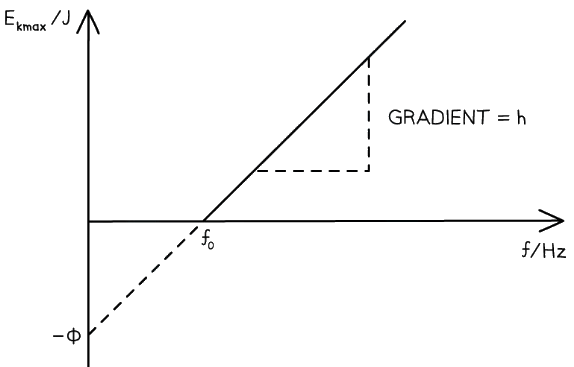
The key elements of the graph:
- The work function Φ is the y-intercept
- The threshold frequency f0 is the x-intercept
- The gradient is equal to Planck's constant h
- There are no electrons emitted below the threshold frequency f0
Example: The graph below shows how the maximum kinetic energy Ek of electrons emitted from the surface of sodium metal varies with the frequency f of the incident radiation.
Calculate the work function of sodium in eV.
Step 1: Write out the photoelectric equation and rearrange to fit the equation of a straight line
E = hf = Φ + ½ mv2max → KEmax = hf - Φ
y = mx + c
Step 2: Identify the threshold frequency from the x-axis of the graph
When Ek = 0, f = f0
Therefore, the threshold frequency is f0 = 4 × 1014 Hz
Step 3: Calculate the work function
From the graph at f0, ½ mvmax2 = 0
Φ = hf0 = (6.63 × 10-34) × (4 × 1014) = 2.652 × 10-19 J
Step 4: Convert the work function into eV
1 eV = 1.6 × 10-19 J J → eV: divide by 1.6 × 10-19

Work Function & Threshold Frequency
The photoelectric effect provides important evidence that light is quantised or carried in discrete packets
- This is shown by the fact each electron can absorb only a single photon
- This means only the frequencies of light above a threshold frequency will emit a photoelectron
Threshold Frequency & Wavelength
- The threshold frequency is defined as:
The minimum frequency of incident electromagnetic radiation required to remove a photoelectron from the surface of a metal - The threshold wavelength, related to threshold frequency by the wave equation, is defined as:
The longest wavelength of incident electromagnetic radiation that would remove a photoelectron from the surface of a metal - Threshold frequency and wavelength are properties of a material, and vary from metal to metal
Threshold frequencies and wavelengths for different metals
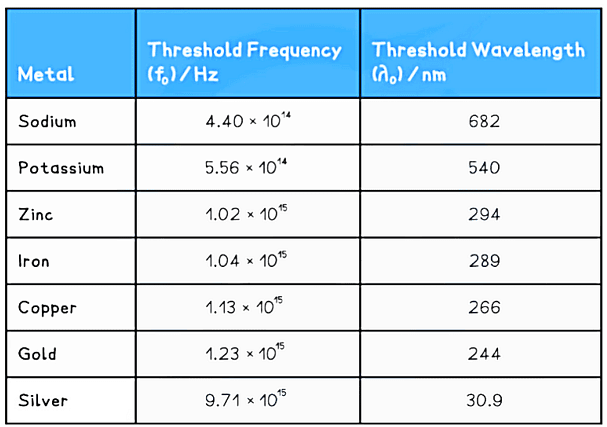
Work Function
- The work function Φ, or threshold energy, of a material, is defined as:
The minimum energy required to release a photoelectron from the surface of a metal - Consider the electrons in a metal as trapped inside an ‘energy well’ where the energy between the surface and the top of the well is equal to the work function Φ
- A single electron absorbs one photon
- Therefore, an electron can only escape from the surface of the metal if it absorbs a photon which has an energy equal to Φ or higher
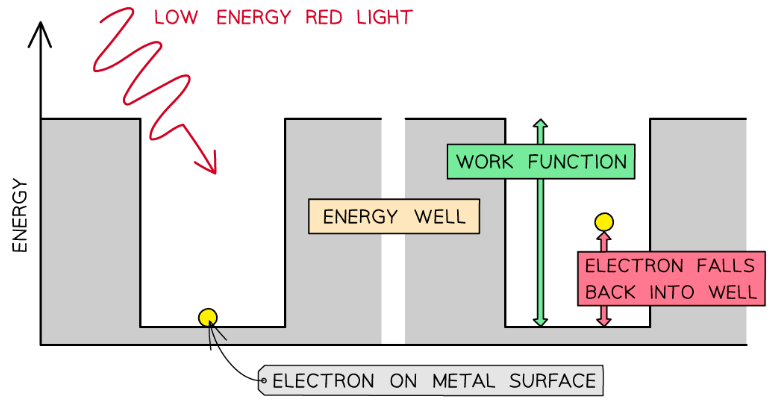

 In the photoelectric effect, a single photon may cause a surface electron to be released if it has sufficient energy
In the photoelectric effect, a single photon may cause a surface electron to be released if it has sufficient energy
- Different metals have different threshold frequencies and hence different work functions
- Using the well analogy:
- A more tightly bound electron requires more energy to reach the top of the well
- A less tightly bound electron requires less energy to reach the top of the well
- Alkali metals, such as sodium and potassium, have threshold frequencies in the visible light region
- This is because the attractive forces between the surface electrons and positive metal ions are relatively weak
- Transition metals, such as zinc and iron, have threshold frequencies in the ultraviolet region
- This is because the attractive forces between the surface electrons and positive metal ions are much stronger
The Maximum Kinetic Energy of Photoelectrons & Intensity
- The maximum kinetic energy of the photoelectrons is independent of the intensity of the incident radiation
- This is because each electron can only absorb one photon
- Kinetic energy is only dependent on the frequency of the incident radiation
- Intensity is a measure of the number of photons incident on the surface of the metal
- So, increasing the number of electrons striking the metal will not increase the kinetic energy of the electrons, it will increase the number of photoelectrons emitted
Rate of Emission of Photoelectrons
- The photoelectric current is the rate of emission of photoelectrons emitted per second
- Photoelectric current is proportional to the intensity of the radiation incident on the surface of the metal
- This is because intensity is proportional to the number of photons striking the metal per second
- Since each photoelectron absorbs a single photon, the photoelectric current must be proportional to the intensity of the incident radiation
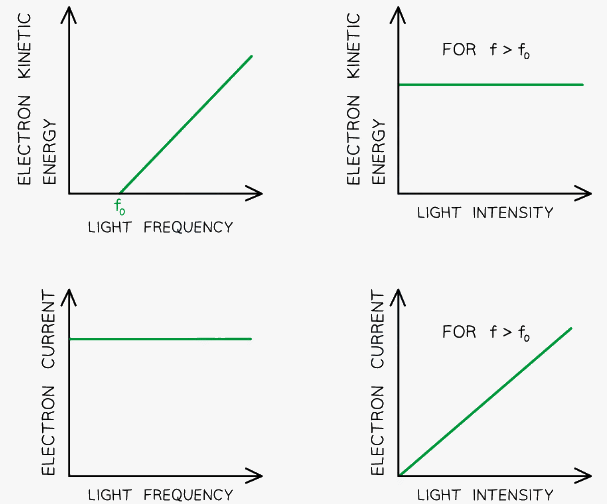 Kinetic energy of photoelectrons is independent of intensity, whereas the photoelectric current is proportional to intensity and independent of frequency
Kinetic energy of photoelectrons is independent of intensity, whereas the photoelectric current is proportional to intensity and independent of frequency
|
142 videos|312 docs|132 tests
|















